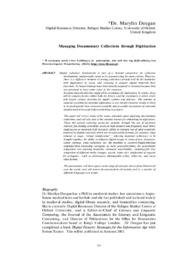Managing documentary collections through digitization
Abstract
Digital collection development is part of a broader perspective on collection development, and generally needs to be assessed using the same criteria. However, there is a difference between reviewing collections already held by the institution with digitization in mind, and choosing to acquire digital materials from elsewhere. In-house holdings have been initially acquired or retained because they are perceived to have some value to the community served by the library, and therefore theoretically they might all be candidates for digitization. In reality, there will be complex factors within both the library and the community it serves which will dictate certain priorities for digital capture and delivery. The amount of material available for potential digitization in any library (however small) is likely to be much greater than resources available and so careful assessments of costs and benefits need to be made before embarking on projects. This paper will review many of the issues attendant upon digitizing documentary collections, and will also look at the complex reasons for embarking on digitization. These will include widening access for students through the use of electronic reserves; facilitating immediate access to high demand and frequently used items; rapid access to materials held remotely; ability to reinstate out-of-print materials; potential to display materials which are in inaccessible formats, for instance, large volumes or maps; ‘virtual reunification’-allowing dispersed collections to be brought together, the ability to enhance digital images in terms of size, sharpness, colour contrast, noise reduction, etc; the potential to conserve fragile/precious originals while presenting surrogates in more accessible forms; the potential for integration into teaching materials; enhanced searchability, including full text; integration of different media (images, sounds, video etc); satisfaction of requests for surrogates-such as photocopies, photographic prints, slides etc. and many other factors. The presentation will draw upon a wide range of examples drawn from libraries all over the world, and will review documents from all periods and in a number of different languages and scripts
